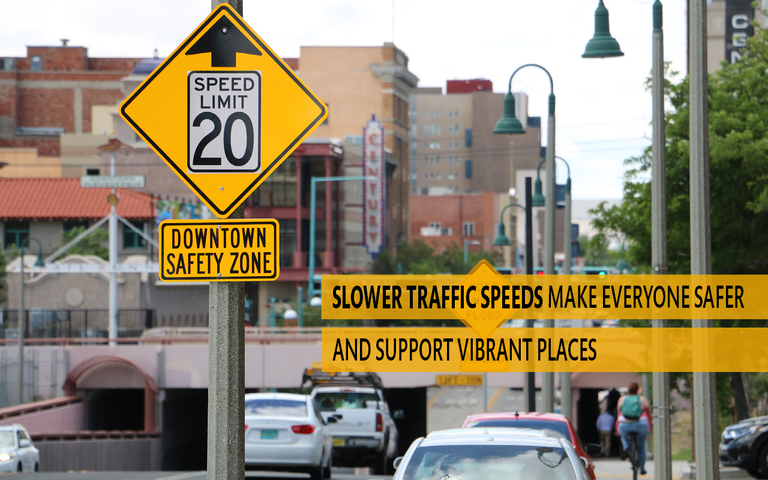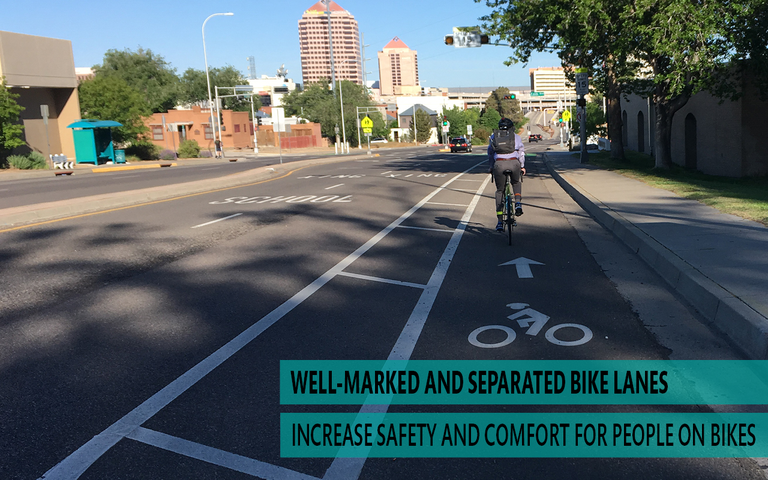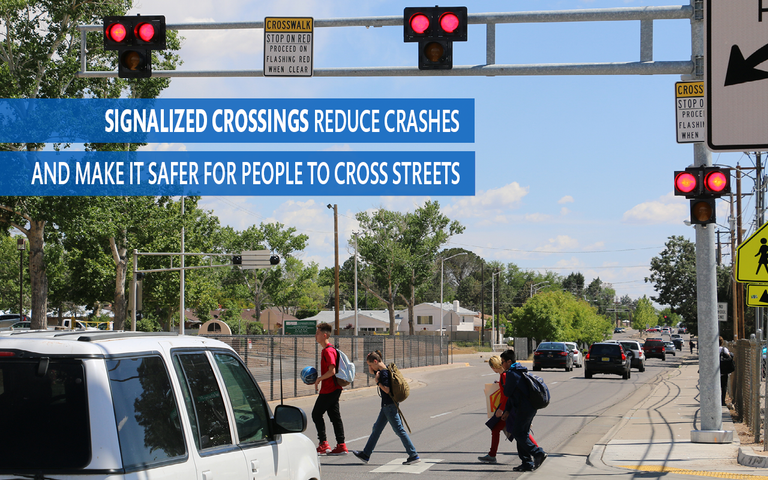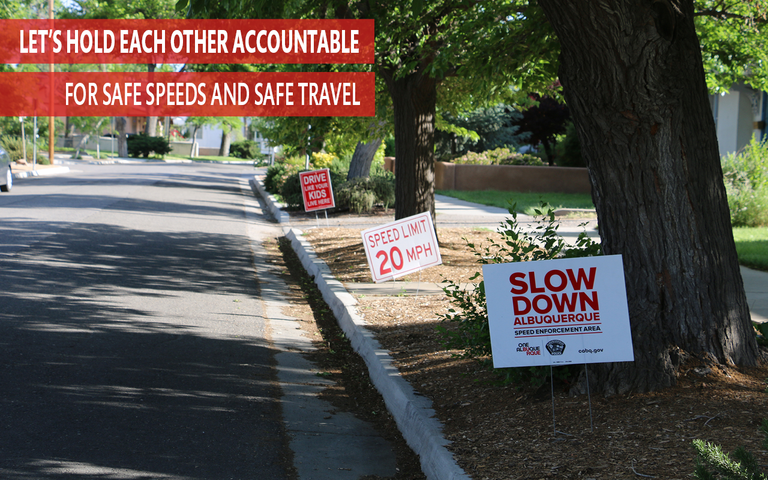What Are We Doing?
Unfortunately, there is no quick fix and lessons learned from other cities show that getting to zero requires long-term investment and commitment. Here are some steps we are already taking toward Vision Zero in our community.
Safe Multimodal Street Design Shift to Active modes Culture of Safety Data and Transparency What You Can Do

- Complete Streets improvements: Every year, the City of Albuquerque conducts routine maintenance on 15 – 25 roadways in the city. Following guidance from the Complete Streets Ordinance (O-19-64), this program is an opportunity to improve safety and increase multi-modal transportation options by identifying locations where the road can be restriped in different ways. Improvements may include new bike lanes, new buffered bike lanes, narrower driving lanes, daylighting, or high visibility crosswalks.
- Louisiana Blvd Traffic Safety Improvements
- 2020 Louisiana Blvd Road Safety Audit: With support from the Federal Highway Administration (FHWA) and the New Mexico Department of Transportation (NMDOT), the City conducted a Pedestrian Road Safety Audit (RSA) on Louisiana Boulevard from Gibson to south of Lomas to identify strategies that will increase safety and make it easier for people to walk and bike in this area. Read the report.
- Louisiana Blvd Vision Zero Improvement Project: Working toward implementing recommendations from the 2020 Road Safety Audit, this project further investigated traffic safety improvements on Louisiana Blvd from Gibson to Central. This project continued community engagement while the City worked toward identifying project implementation phases. It also further studied and designed a road diet with separated bikeways, and curb extensions. Construction for this project is complete. Read the solutions. Read the Community Engagement Summary.
- Louisiana Blvd Vision Zero Improvement Project (Mid-block Crossings). Three mid-block crossings: The City received Highway Safety Improvement Program (HSIP) Vulnerable Roadway User (VRU) funding from the Federal Highway Administration (FHWA) to construct three mid-block crossings with pedestrian hybrid beacons (PHBs), also known as HAWK signals, on Louisiana Blvd between Gibson and Central. This project is currently in design with expected construction in 2025-2026. The three locations: between Eastern and Ross, between Ross and Anderson, and between Bell and Zuni.
- East Central business access & transit (BAT) lanes and mid-clock crossings. This project will design and construct business access & transit (BAT) lanes on Central Ave between Louisiana Blvd and Juan Tabo Blvd. It will also include two mid-block crossings with pedestrian refuge islands and pedestrian hybrid beacons at Central near Britt and Central near Dorothy. This project is currently bidding.
- Neighborhood Traffic Management Program: This program implements traffic calming tools to address speeding and cut-through traffic on local residential streets.
- Automated Speed Enforcement: In May 2022, the City of Albuquerque started the Automated Speed Enforcement Program. Safe speeds are a core principle of Albuquerque’s Vision Zero approach since we know from comprehensive data that humans are less likely to survive high-speed crashes. Read the Automated Speed Enforcement FAQs.
- Downtown Safety Zone: 20 mph speed limit downtown and improvements to increase walkability and bike friendliness throughout downtown.

The City's Transportation Planning Team organizes Bike to Work Day. This annual event is an opportunity to try out bicycling for transportation – it’s good for the environment, health, and it’s fun! This City event would not be possible without volunteers, local business support, and community advocates. It occurs annually in May.

- Bicycle and Trail Crossings Guide: Takes national guidance and best practices for bicycle and pedestrian crossings and adapts it to consider Albuquerque’s roadways. Helps to determine the feasibility and appropriate design for crossing treatments. The City finalized this Guide in Spring 2022, and our planners and engineers are using it in their projects. This document was also included in the 2024 Bikeway and Trail Facilities Plan (unanimously adopted at City Council in December 2024). Read the Plan.
- Complete Streets Ordinance: In 2019, City Council adopted an update to the City’s Complete Streets Ordinance, calling for attention to both equity and safety in roadway projects.
- School Crossings: Staff conducted a school crossing study and installed PHB/HAWK and RRFB signals at school crossings based on study recommendations, and refreshed crosswalks and signage near schools. Read the Study and view a Story Map of findings for each school.
- O-2022-038 also known as the “Pedestrian Safety Ordinance”: The City’s Vision Zero program supports any effort to make streets safer for all roadway users – especially people walking. Read the Pedestrian Safety Ordinance.
- Albuquerque Public Schools (APS) Vision Zero for Youth Initiative: This effort created a student-focused traffic safety campaign with a traffic safety curriculum, campaign materials, and community outreach. City transportation planning and engineering staff serve on the task force.
- Esperanza Bicycle Safety Education Center: Operated by the City of Albuquerque Parks and Recreation Department. They provide bicycle education, with the goal of increasing the safety, self-sufficiency, and comfort of recreational, fitness, and utility riders alike. Esperanza provides classes and programs of varied types and topics, including bicycle safety, road use and traffic law, mechanics, and riding skills.
- Balloon Fiesta Bike Valet: Our community is committed to increasing awareness about traffic safety and providing opportunities for walking and biking.
- DMD and APD have recurring fatal and serious injury crash review meetings.
- A data-driven approach is used throughout Vision Zero efforts. Learn more about the High Fatal and Injury Network prioritization and transportation projects that include traffic safety components, which support Vision Zero.
Getting to zero requires a commitment from all of us to be careful and watch out for one another when we are on the road. Here’s how you can help:
- Take the Albuquerque Safe Streets Pledge.
- Respect all other road users - we are all going somewhere, and we all have the right to get there safely.
- Slow down - slower speeds save lives!
- Eliminate distractions - focus on the road and look for other people using the road.
- Stop at red signal lights and stop signs - make a complete stop then look for other people walking, biking, and driving before proceeding.
- Yield to people walking and biking and be extra cautious around crossings.
- Never drive when under the influence of drugs or alcohol.
Keep up-to-date with Vision Zero efforts by participating in the monthly Greater Albuquerque Active Transportation Committee (GAATC) meeting. Learn more.
